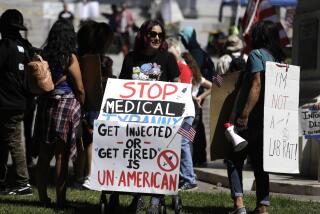Suspect stood to gain from anthrax panic
Bruce E. Ivins, the government biodefense scientist linked to the deadly anthrax mailings of 2001, stood to gain financially from massive federal spending in the fear-filled aftermath of those killings, the Los Angeles Times has learned.
Ivins is listed as a co-inventor on two patents for a genetically engineered anthrax vaccine, federal records show. Separately, Ivins also is listed as a co-inventor on an application to patent an additive for various biodefense vaccines.
Ivins, 62, died Tuesday in an apparent suicide in Maryland. Federal authorities had informed his lawyer that criminal charges related to the mailings would be filed.
As a co-inventor of a new anthrax vaccine, Ivins was among those in line to collect patent royalties if the product had come to market, according to an executive familiar with the matter.
The product had languished on laboratory shelves until the Sept. 11 attacks and the anthrax mailings, after which federal officials raced to stockpile vaccines and antidotes against potential biological terrorism.
A San Francisco-area biotechnology company, VaxGen, won a federal contract worth $877.5 million to provide batches of the new vaccine. The contract was the first awarded under legislation promoted by President Bush, called Project BioShield.
One executive who was familiar with the matter said that, as a condition of its purchasing the vaccine from the Army, VaxGen had agreed to share sales-related proceeds with the inventors.
“Some proportion would have been shared with the inventors,” said the executive, who spoke anonymously because of contractual confidentiality. “Ivins would have stood to make tens of thousands of dollars, but not millions.”
Two years after the contract was awarded to VaxGen, the pact was terminated when the company could not deliver its batches on schedule. The termination meant that VaxGen was not paid, nor were Ivins and his co-inventors.
Ivins also was listed as one of two inventors of another biodefense-related product that has won federal sponsorship.
According to their still-pending application for a U.S. patent, the inventors hoped the additive would bolster certain vaccines’ capacity to prevent infections “from bioterrorism agents.”
From December 2002 to December 2003, the Pentagon’s Defense Advanced Research Projects Agency committed $12 million for additional testing of the experimental additive. That research money was designated for Coley Pharmaceutical Group, which was developing the additive. The company was acquired last fall by Pfizer Corp.
Samuel C. Miller, a Georgetown Law Center professor who is a patent-law expert, said that the extent to which Ivins stood to gain from the two issued patents or the one that remains pending hinges on the terms of the related contracts.
“It will depend on the business arrangements that are in place,” Miller said.
On Friday, colleagues and critics of Ivins pondered the mystery within the mystery: If Ivins did it, why?
One former senior official with Ivins’ employer, the U.S. Army Medical Research Institute of Infectious Diseases, whom the FBI questioned at length about Ivins, said he believed his former colleague wanted more attention -- and resources -- shifted to biological defense.
“It had to have been a motive,” said the former official, who suspects that Ivins was the culprit. “I don’t think he ever intended to kill anybody. He just wanted to prove ‘Look, this is possible.’ He probably had no clue that it would aerosolize through those envelopes and kill those postal workers.”
Of the five people killed by the mailings, two worked for the U.S. Postal Service in the Washington, D.C., area; one was a photo editor in Palm Beach County, Fla.; another was a hospital supply provider in New York City; and the last known victim was a 94-year-old woman in Connecticut.
Several letters were addressed to prominent people -- two U.S. senators and NBC news anchor Tom Brokaw, for example.
For nearly 30 years, Ivins served far from the limelight, a PhD microbiologist who drew a civil servant’s pay while handling some of the most deadly pathogens on Earth -- live spores of anthrax.
The deadly mailings of anthrax-tainted envelopes transported Ivins from the backwater of government scientific research at Ft. Detrick, Md., to the center of the nation’s fledgling war on terrorism. It also spurred multibillion-dollar national security initiatives.
Ivins was thrust into the federal investigation of the mailings as well. He helped the FBI analyze anthrax recovered from a letter addressed to then-Senate Majority Leader Tom Daschle (D-S.D.).
He also played a lead role in helping a private company, BioPort, win regulatory approval to continue making the vaccine required for U.S. service personnel deployed to Iraq, Afghanistan and other regions.
From 2000 to early 2002, Ivins and two colleagues from USAMRIID helped BioPort resolve problems related to the potency of the vaccine. Because of those and other manufacturing difficulties, production had been suspended. The efforts of Ivins and his colleagues helped BioPort win FDA approval to resume production.
At a Pentagon ceremony on March 14, 2003, Ivins and two colleagues from USAMRIID were bestowed the Decoration of Exceptional Civilian Service, the highest honor given to nonmilitary employees of the Defense Department.
“Awards are nice,” Ivins said in accepting the honor. “But the real satisfaction is knowing the vaccine is back on line.”
The Times sought earlier this year to obtain annual financial disclosure statements filed by Ivins with his employer. USAMRIID spokeswoman Caree Vander Linden said last month that Ivins had filed financial reports exempt from disclosure under the Freedom of Information Act.
Ivins’ apparent suicide and the Justice Department’s decision to bring criminal charges against him were first reported Thursday night by The Times. On Friday, Ivins’ lawyer, Paul F. Kemp, defended his client and said that Ivins had cooperated fully with the FBI.
“We assert his innocence in these killings, and would have established that at trial,” Kemp said, implicitly confirming that Ivins had been about to be formally charged. “The relentless pressure of accusation and innuendo takes its toll in different ways on different people. . . . In Dr. Ivins’ case, it led to his untimely death.”
Kemp did not respond to telephone calls and e-mails for this article.
--
Times researcher Janet Lundblad contributed to this report.
--
(BEGIN TEXT OF INFOBOX)
Key dates in the investigation of the anthrax attacks
2001
September-October: Anthrax is mailed to lawmakers on Capitol Hill and members of the news media in New York and Florida. By late November, five people are dead and 17 sickened. The victims include postal workers and others who came into contact with the anthrax.
2002
January: The Senate office building where anthrax- tainted letters were sent reopens after three months and fumigation. FBI doubles the reward for helping solve the case to $2.5 million.
June: The FBI is scrutinizing 20 to 30 scientists who might have had the knowledge and opportunity to send the anthrax letters, a U.S. official says.
August: Law enforcement officials and Atty. Gen. John D. Ashcroft call Steven J. Hatfill, a biowarfare expert, a “person of interest” in the investigation.
2003
June: The FBI drains a pond in Frederick, Md., in search of evidence. Frederick is the home of the Army Medical Research Institute of Infectious Diseases, one of the nation’s main anthrax research centers. Nothing suspicious is found.
August: Hatfill sues Ashcroft and other government officials, accusing them of using him as a scapegoat and demanding that they clear his name.
December: Postal workers begin moving back into Washington’s main mail center, more than two years after anthrax-laced letters killed two employees. The Brentwood facility underwent more than $130 million worth of decontamination and renovation.
2004
August: FBI searches homes of Dr. Kenneth M. Berry, who founded a group to train medical staffers to respond to biological disasters, as part of the anthrax investigation. No charges are filed.
July 11: Bio-ONE, a company founded by former New York City Mayor Rudolph W. Giuliani, fumigates the former headquarters of the Sun, the Florida supermarket tabloid that was the first target in the anthrax attacks.
July 13: Hatfill sues the New York Times for defamation, claiming the newspaper ruined his reputation after it published a series of columns pointing to him as the culprit.
2005
March 10: Sensor at Pentagon mail room indicates the possible presence of anthrax.
March 14: Alarm at a second Pentagon mail facility also signals a possible anthrax presence. The post office in Hamilton, N.J., that handled anthrax-laced letters in 2001 reopens. Further testing determines no anthrax in Pentagon mail rooms.
2006
April 11: It is reported that Hatfill’s lawyers have questioned at least two journalists and are subpoenaing others, seeking identities of their confidential government sources.
Oct. 23: A federal judge orders the New York Times to disclose a columnist’s confidential sources.
2007
Jan. 12: A federal judge dismisses Hatfill’s libel lawsuit against the New York Times.
Aug. 13: A federal judge says five journalists must identify the government officials who leaked details about Hatfill to them.
Oct. 2: Hatfill asks a federal judge to hold two journalists in contempt for refusing to identify their sources.
2008
March 7: A federal judge holds a former USA Today reporter in contempt and orders her to pay up to $5,000 a day if she refuses to identify her sources for stories about Hatfill.
March 11: A federal appeals court blocks the fines.
June 27: The government awards Hatfill $5.8 million to settle his violation of privacy lawsuit against the Justice Department.
July 29: Bruce E. Ivins, 62, dies of an apparent suicide at a hospital in Frederick, Md., after being informed by the FBI that charges probably were going to be brought against him in connection with the 2001 anthrax attacks.
Source: Associated Press
--
(BEGIN TEXT OF INFOBOX)
A killer bacterium
The spores that cause anthrax -- Bacillus anthracis -- occur widely in soil, and the skin form of the infection used to be common, especially among livestock and people who work with the animals. It can be treated with antibiotics.
But once the spores are inhaled and settle in the lungs, they cause a hard-to-diagnose infection that is almost impossible to cure -- and nearly always fatal -- once symptoms start.
Experts estimate that 8,000 to 10,000 spores taken into the lungs can cause inhaled anthrax. The infection is not contagious.
Infection with the skin form of the disease can result from substantially fewer spores. On the skin, the ailment starts after three to five days with a small, painless blister that is red around the edges. A day or two later, this becomes an open sore that is especially recognizable because it is black. Eventually, this dries up and leaves a black scab, which falls off after a week or two.
The usual treatment is a common antibiotic, such as penicillin, doxycycline or Cipro, which are extremely effective.
Left untreated, perhaps 5% of skin cases progress to a dangerous bloodstream infection, which also is almost always fatal, according to medical experts.
--
Source: Associated Press
More to Read
Sign up for Essential California
The most important California stories and recommendations in your inbox every morning.
You may occasionally receive promotional content from the Los Angeles Times.











